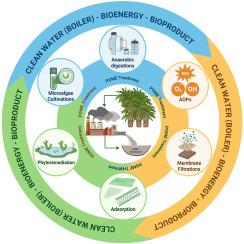Development of wastewater treatment methods for palm oil mill effluent (POME): A comprehensive review
引用次数: 0
Abstract
As the world’s largest palm oil producer, Indonesia significantly benefits from its palm oil industry but also faces serious environmental challenges from palm oil mill effluent (POME)—a high-strength wastewater containing substantial organic matter, nutrients, suspended solids, and various chemical compounds. Sustainable and effective wastewater treatment strategies are urgently needed to address this issue. This review presents a comprehensive analysis of existing POME treatment technologies, including anaerobic digestion (AD), advanced oxidation processes (AOPs), membrane filtration, adsorption, phytoremediation, and microalgae-based systems. Each method is examined in terms of treatment efficiency, operational feasibility, and potential for implementation under Indonesian conditions. While advanced processes, such as AOPs and membrane filtration, achieve high pollutant removal, they are often limited by operational costs. In contrast, biological approaches, such as AD and phytoremediation, offer both environmental benefits and economic value through the recovery of biogas, biofertilizers, and biomass. This review highlights the potential for integrating wastewater purification with resource recovery and valorization, supporting a shift toward more circular and sustainable management of POME. The insights provided are intended to guide future research, inform policy decisions, and facilitate the industrial adoption of optimized treatment systems.

棕榈油厂废水处理方法的发展综述
作为世界上最大的棕榈油生产国,印度尼西亚从其棕榈油工业中受益匪浅,但也面临着棕榈油厂废水(POME)带来的严重环境挑战。POME是一种含有大量有机物、营养物质、悬浮固体和各种化合物的高强度废水。为了解决这一问题,迫切需要可持续和有效的废水处理策略。本文综述了现有的POME处理技术,包括厌氧消化(AD)、高级氧化工艺(AOPs)、膜过滤、吸附、植物修复和微藻系统。每一种方法都在处理效率、操作可行性和在印度尼西亚条件下实施的潜力方面进行了审查。虽然先进的工艺,如AOPs和膜过滤,可以实现高的污染物去除,但它们往往受到运营成本的限制。相比之下,生物方法,如AD和植物修复,通过回收沼气、生物肥料和生物质,提供环境效益和经济价值。这篇综述强调了将废水净化与资源回收和增值相结合的潜力,支持向更循环和可持续的POME管理转变。所提供的见解旨在指导未来的研究,为政策决策提供信息,并促进工业采用优化的处理系统。
本文章由计算机程序翻译,如有差异,请以英文原文为准。
求助全文
约1分钟内获得全文
求助全文

 求助内容:
求助内容: 应助结果提醒方式:
应助结果提醒方式:


